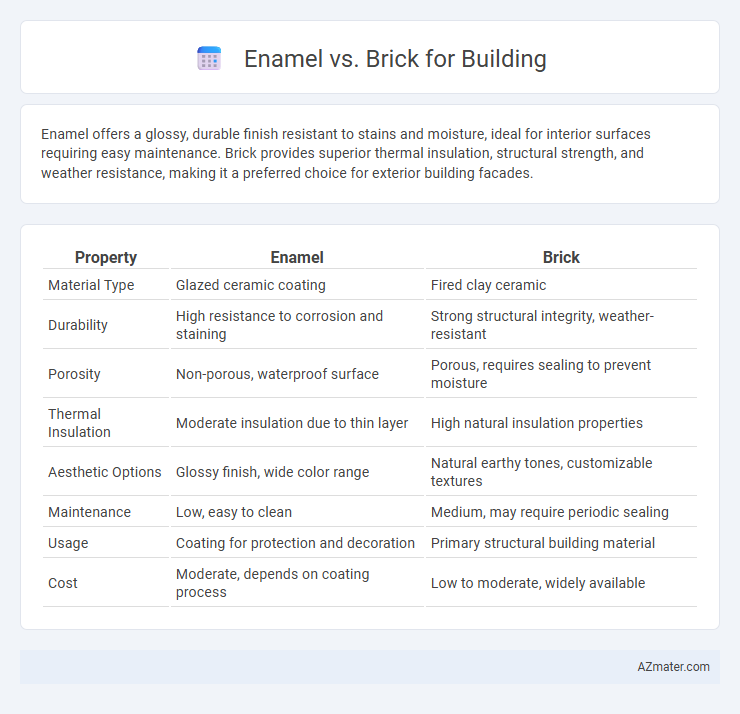Enamel offers a glossy, durable finish resistant to stains and moisture, ideal for interior surfaces requiring easy maintenance. Brick provides superior thermal insulation, structural strength, and weather resistance, making it a preferred choice for exterior building facades.
Table of Comparison
| Property | Enamel | Brick |
|---|---|---|
| Material Type | Glazed ceramic coating | Fired clay ceramic |
| Durability | High resistance to corrosion and staining | Strong structural integrity, weather-resistant |
| Porosity | Non-porous, waterproof surface | Porous, requires sealing to prevent moisture |
| Thermal Insulation | Moderate insulation due to thin layer | High natural insulation properties |
| Aesthetic Options | Glossy finish, wide color range | Natural earthy tones, customizable textures |
| Maintenance | Low, easy to clean | Medium, may require periodic sealing |
| Usage | Coating for protection and decoration | Primary structural building material |
| Cost | Moderate, depends on coating process | Low to moderate, widely available |
Introduction: Comparing Enamel and Brick in Construction
Enamel and brick serve distinct roles in construction, with enamel primarily used as a protective and decorative coating on surfaces, while brick functions as a fundamental structural material. Enamel offers durability, resistance to weathering, and ease of maintenance, making it ideal for enhancing exterior and interior finishes. Brick provides exceptional thermal insulation, strength, and longevity, forming the load-bearing framework of buildings and contributing to energy efficiency and architectural aesthetics.
Material Composition: Enamel vs Brick
Enamel, a glassy coating fused onto metal or ceramic surfaces, consists primarily of silica, fluxes, and metal oxides, providing a smooth, non-porous, and highly durable finish ideal for protective and decorative applications. Brick, composed primarily of clay, shale, and sand, is fired at high temperatures to create a porous, robust, and thermally insulating building material. The inorganic mineral composition of bricks allows them to absorb and release moisture, whereas enamel's vitreous surface is impermeable, influencing their respective uses in construction and design.
Strength and Durability Factors
Enamel coatings provide a hard, smooth surface resistant to corrosion and weathering, enhancing the longevity of metal structures but lacking substantial load-bearing strength. Brick offers superior compressive strength and durability, making it ideal for structural stability and long-term wear in construction. For projects requiring robust, load-bearing materials, brick outperforms enamel-coated surfaces in strength and long-term durability.
Thermal Insulation Properties
Enamel surfaces provide limited thermal insulation, primarily reflecting heat but lacking substantial resistance to temperature transfer compared to brick. Brick, composed of dense, porous materials, offers superior thermal mass that regulates indoor temperature by absorbing and slowly releasing heat. This makes brick a more effective choice for maintaining energy efficiency and comfort in building applications.
Aesthetic Appeal and Design Flexibility
Enamel surfaces offer a glossy, vibrant finish that enhances aesthetic appeal with a wide spectrum of colors and modern design possibilities, making them ideal for contemporary architecture. Brick provides a timeless, rustic charm with earthy tones and natural textures, contributing to an enduring visual warmth and classic architectural styles. Enamel's design flexibility allows customization with intricate patterns and smooth surfaces, while brick excels in textured facades and structural detailing for traditional and industrial designs.
Cost Analysis: Initial Investment and Long-term Value
Brick construction typically requires a higher initial investment due to labor-intensive installation and material costs averaging $7 to $15 per square foot, while enamel finishes range from $3 to $8 per square foot, making them more budget-friendly upfront. Over time, brick demonstrates superior durability and low maintenance expenses, often increasing property value by 2-5%, whereas enamel surfaces may require periodic refinishing or replacement, impacting long-term cost-efficiency. Evaluating the total cost of ownership reveals brick as a more economical option for long-term value despite its higher initial cost, benefiting projects with extended lifespans.
Environmental Impact and Sustainability
Enamel coatings offer a lower environmental footprint by reducing the need for frequent repainting and enhancing the durability of building surfaces, thus minimizing resource consumption over time. Brick, a natural and highly durable material, provides excellent thermal mass that improves energy efficiency by maintaining stable indoor temperatures, reducing heating and cooling demands. The production of bricks involves significant energy use and CO2 emissions, whereas advances in enamel formulations aim to decrease VOC emissions and utilize eco-friendly raw materials, contributing to sustainable building practices.
Maintenance and Lifespan Considerations
Enamel surfaces offer low maintenance with easy cleaning and high resistance to stains and corrosion, ideal for buildings exposed to harsh weather conditions. Brick structures require regular upkeep such as repointing mortar joints and sealing to prevent water damage but provide exceptional durability and can last over a century with proper care. Considering lifespan, brick outperforms enamel with its natural strength and longevity, while enamel's maintenance benefits suit modern aesthetic and functional needs.
Applications and Suitable Building Types
Enamel coatings provide a durable, weather-resistant finish ideal for metal structures, commercial facades, and modern residential buildings requiring low maintenance and vibrant aesthetics. Brick offers exceptional thermal insulation and structural strength, making it suitable for traditional homes, load-bearing walls, and heritage architecture where longevity and classic appeal are prioritized. Both materials cater to different design requirements, with enamel excelling in sleek, contemporary applications and brick favored in robust, insulating constructions.
Conclusion: Choosing Between Enamel and Brick
Selecting between enamel and brick for construction depends on project requirements, with enamel offering a sleek, durable, and low-maintenance surface ideal for modern designs, while brick provides timeless aesthetic appeal, superior insulation, and robust structural strength. Enamel excels in environments demanding hygienic, stain-resistant finishes, whereas brick is preferred for its thermal mass, weather resistance, and classic look. Cost considerations, climate, and desired building longevity further influence the optimal material choice.

Infographic: Enamel vs Brick for Building
 azmater.com
azmater.com